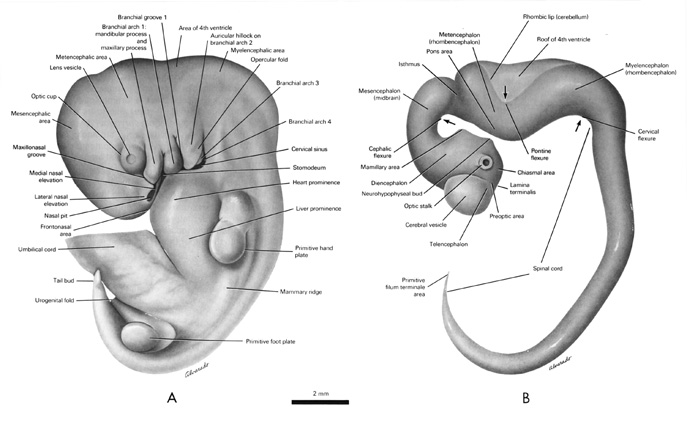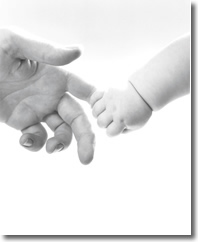Prenatal Form and Function – The Making of an Earth Suit
Unit 6: 5 to 6 Weeks
 Closer Look:
Closer Look:
 Applying the Science:
Applying the Science:

Copyright © 2006 EHD, Inc. All rights reserved.

Cartilage formation begins by 5½ weeks.1
By 5½ weeks, retinal pigment is subtly visible externally.2
By 6 weeks a portion of the brain called the cerebral cortex (ser’e-bral kor’teks) appears.3 Nerve cells, or neurons, in the spinal cord now begin to develop specialized connections.4 These connections, where neurons meet and communicate with one another, are called synapses.5

Copyright © 2002 Lippincott, Williams & Wilkins.
Movement Begins
Though a pregnant woman does not feel movement for at least another 8 to 10 weeks, the embryo begins to move between 5 and 6 weeks.6 The embryo’s first movements are both spontaneous and reflexive.7 A light touch to the mouth area causes the embryo to reflexively withdraw its head, 8 while the embryo’s trunk will twist spontaneously. Movements are essential for the normal development of bones and joints.9
By 6 weeks, the external ear begins to take shape,10 and the opening of the ear canal becomes visible. Salivary glands also appear inside the mouth.11


Copyright © 2002 Lippincott, Williams & Wilkins.

Blood formation is now actively underway in the liver12 and contributes to the liver’s bright red color.13 The rapidly growing liver also begins producing lymphocytes.14 This type of white blood cell is a key part of the developing immune system.



By 5½ weeks, 5 linear digital rays begin forming the bones in the hand including the thumb and fingers.15 Wrist formation is also underway.16
At 6 weeks, the embryo’s hand plates develop a subtle flattening and linear digital rays now become noticeable.17 These digital rays form the bones of the fingers and metacarpals of each hand as development progresses.
By 5½ weeks, nipples appear near the embryo’s underarm.18 We will see their location change as they reach their final position on the chest wall.
The diaphragm (di’a-fram), the primary muscle used in breathing, is largely formed by 6 weeks.19

Copyright © 2006 EHD, Inc. All rights reserved.
By 6 weeks, a portion of the intestine begins to temporarily protrude outside the abdominal cavity. It extends into the umbilical cord. This normal process, called physiologic herniation (fiz-e-o-loj’ik her-ne-a’shun), makes room for other developing organs in the abdomen, such as the liver.20

Copyright © 2006 EHD, Inc. All rights reserved.

The endocrine system continues to develop during week 6, producing hormones which will help control numerous functions of the body. The parathyroid glands form in the neck area by 6 weeks and eventually secrete a hormone which helps regulate calcium levels in the blood.21 Over each kidney the adrenal cortex also forms and soon will secrete hormones which help manage stress and balance salt and fluid levels.
The pancreas now begins producing glucagon,22 an important hormone that prevents blood sugar levels from dropping dangerously low.








